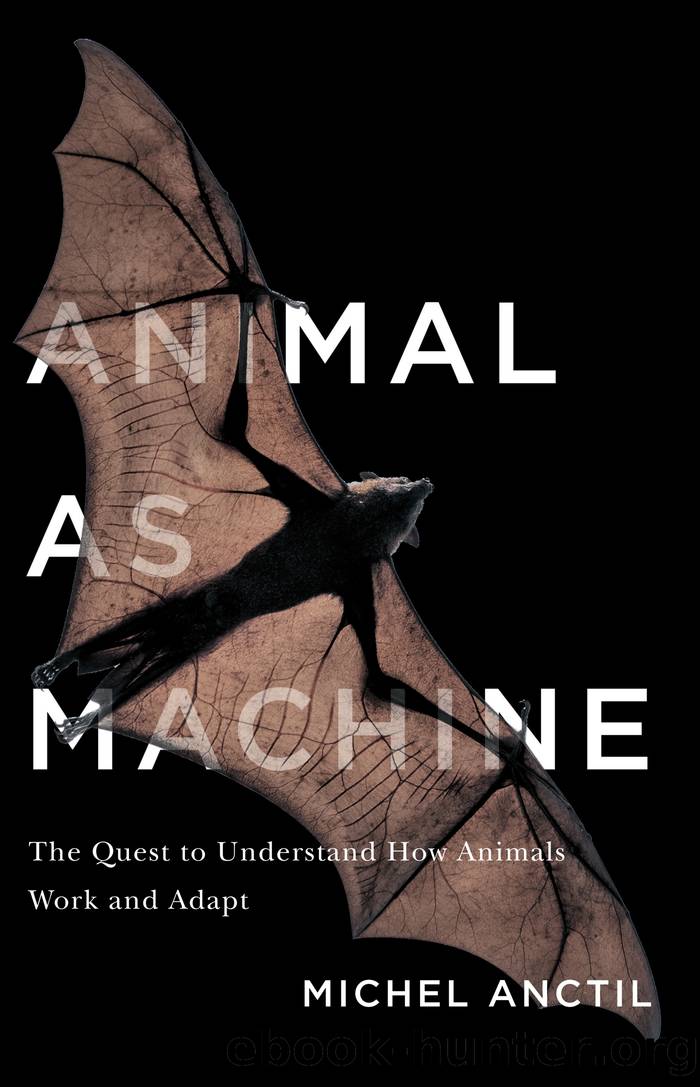Animal As Machine by Anctil Michel;

Author:Anctil, Michel;
Language: eng
Format: epub
Publisher: McGill-Queen's University Press
Published: 2022-06-15T00:00:00+00:00
An example of biotic interaction in which molecules are involved are the amino acids dissolved in water by the decay of zooplankton. Many organisms such as sea anemones and starfish absorb these amino acids through their skin as a nutritive supplement to amino acids in prey ingested through their digestive system. Florkin and Schoffeniels revelled in providing multiple such examples. The molecular approach to ecology, in their view, helped dispel the notion that animal courtship and social behaviour are due to the nebulous instinct; pheromones and other chemical signals act with other sensory cues to shape social cohesion in an animalâs ecosystem (see chapter 10).
An important aspect of Florkinâs legacy was his assistance in the foundation of a new journal, Comparative Biochemistry and Physiology. Up until 1960 no journal dealing with comparative physiology had dedicated a section to comparative biochemistry. Even when the Journal of Comparative Physiology, as the Zeitschrift für vergleichende Physiologie became known, produced a separate section that included biochemistry, the latter had to be shared with systems and environmental physiology, and it happened only in 1984. So the opportunity for greater visibility that the new journal afforded comparative biochemistry was not to be spurned. This visibility seemed even glaring, as âbiochemistryâ came ahead of âphysiologyâ in the journal title, although it is not clear if its placement signalled a hierarchy of importance or an alphabetical order.
The impetus for such a journal emerged from discussions between two quirky and controversial individuals: Gerald A. Kerkut (1927â2004) and Robert Maxwell (1923â1991). Kerkut studied at Cambridge University, where he completed a PhD in zoology on the locomotion of starfish. His contrary personality emerged early on, according to his associate Robert Walker (2004), as âhis ability to antagonise resulted in his never fully achieving the acclaim many felt he deserved.â As Kerkut saw no future for him in Cambridge, he took a position as a lecturer in the Department of Zoology at the University of Southampton in 1954, and by 1960 in its new Department of Physiology and Biochemistry. He was a neurophysiologist and the research that brought him recognition concerned the electrophysiology and neurotransmission mechanisms of giant nerve cells in garden snails (Kerkut et al. 1975).
Maxwell, on the other hand, was cut from different cloth: not a scientist, not an intellectual, but an entrepreneurial British Jew whose bag of tricks, if his biographer Tom Bower (1992) is to be believed, cannot fail to recall Mordecai Richlerâs novel Duddy Kravitz. Born in a Jewish enclave in what was then the Czechoslovak Republic, near the border with Hungary, Maxwell (then named Jan Ludvik Hoch) fled in 1939 after Hitler invaded Czechoslovakia. He eventually ended up in Great Britain and served commendably in World War II, earning a Military Cross. His fluency in several languages led to his work as a field intelligence officer and the alias âRobert Maxwell,â which stuck for the rest of his life. His assignment in the Public Relations and Information Services Control in British-occupied Berlin after the war built
Download
This site does not store any files on its server. We only index and link to content provided by other sites. Please contact the content providers to delete copyright contents if any and email us, we'll remove relevant links or contents immediately.
Sapiens: A Brief History of Humankind by Yuval Noah Harari(13954)
The Tidewater Tales by John Barth(12382)
Mastermind: How to Think Like Sherlock Holmes by Maria Konnikova(6911)
Do No Harm Stories of Life, Death and Brain Surgery by Henry Marsh(6672)
The Thirst by Nesbo Jo(6420)
Why We Sleep: Unlocking the Power of Sleep and Dreams by Matthew Walker(6326)
Life 3.0: Being Human in the Age of Artificial Intelligence by Tegmark Max(5165)
Sapiens by Yuval Noah Harari(5106)
The Longevity Diet by Valter Longo(4845)
The Body: A Guide for Occupants by Bill Bryson(4559)
The Rules Do Not Apply by Ariel Levy(4504)
The Immortal Life of Henrietta Lacks by Rebecca Skloot(4233)
Why We Sleep by Matthew Walker(4186)
Animal Frequency by Melissa Alvarez(4137)
Yoga Anatomy by Kaminoff Leslie(4095)
The Hacking of the American Mind by Robert H. Lustig(4068)
All Creatures Great and Small by James Herriot(3969)
Barron's AP Biology by Goldberg M.S. Deborah T(3930)
Double Down (Diary of a Wimpy Kid Book 11) by Jeff Kinney(3900)
